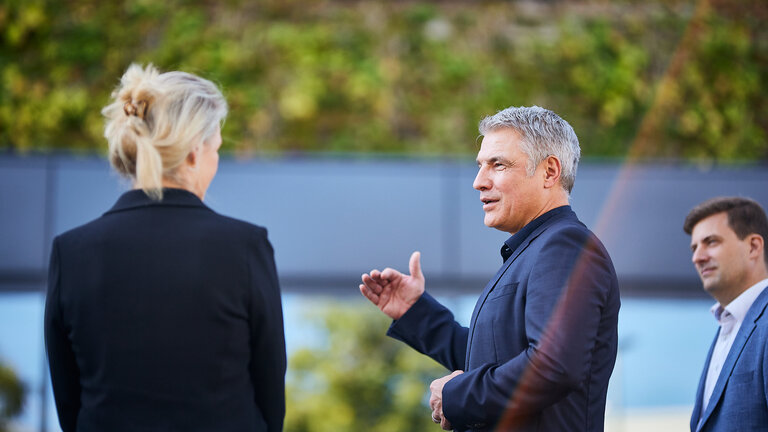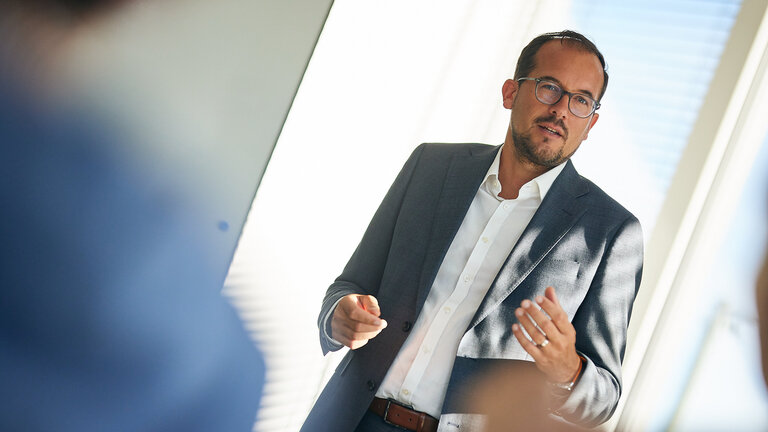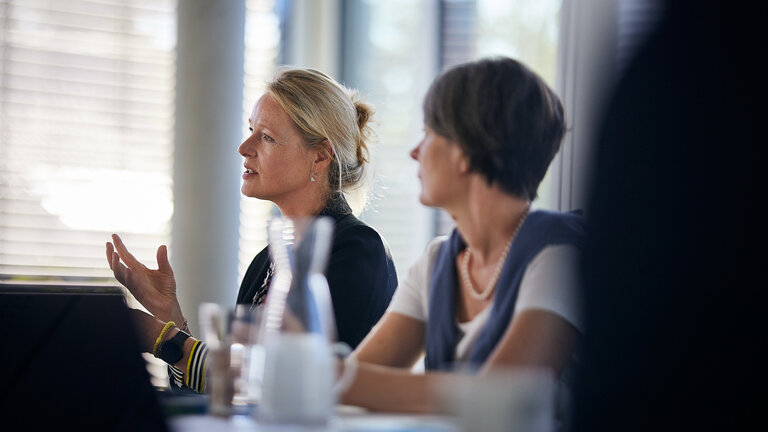Stuttgart, Germany, September 4, 2023. Hardly anyone still doubts the negative impact of air travel and coal-fired power plants on the climate, not to mention our shopping habits and consumer behavior. Yet few consider the real estate and construction sector as a ‘climate killer’, even though it accounts for around 40 percent of global greenhouse gas emissions. In addition, half of the global waste that is produced comes from the construction or deconstruction of buildings. “Energy-efficient renovation and circular construction methods are key topics. This involves protecting the climate more, using less energy and smart recycling of raw materials,” says Thekla Walker, Minister of the Environment, Climate Protection and Energy Sector of the German federal state of Baden Württemberg. With coordination by her Ministry, the state government developed a comprehensive package of measures for climate change adaptation, which was adopted at the end of July. An important part of this is urban and regional planning. Steffen Szeidl, Member of Drees & Sommer’s Executive Board, and Professor Dr. Michael Bauer, Partner at Drees & Sommer SE, spoke with the Minister about the relevance of the buildings sector in this connection, taking the company’s new headquarters in Stuttgart’s Vaihingen district, the OWP12 building, as an example.
The special feature of the new building at the company campus in Stuttgart is that the office building with a green façade provides answers to the climate crisis; as a net plus energy building, it also represents the switch to renewable energy sources in the buildings sector. It generates more energy than it consumes in operation and has also been designed to be recyclable as far as possible. With more than 5,500 employees, the consulting firm brings the knowledge gained from its own new building into the 5,000+ construction projects that it handles worldwide.
“The best way to prove what is economically viable and worthwhile on a sustainable basis is to demonstrate it by leading the way and putting it into practice oneself,” comments Drees & Sommer’s Executive Board Member Steffen Szeidl. For this reason, the company has also been part of the Baden-Württemberg Climate Alliance since the beginning of the year. This is a voluntary partnership between the federal state and companies, with the aim of reducing greenhouse gas emissions and energy consumption, and becoming carbon-neutral.
Accelerating the Transition to Green Heating
For the buildings sector as a sleeping giant, the green heating energy transition means that fossil-based energy is on its way out. By the end of the year, the federal state's 104 district-free cities and the major district cities must outline how they plan to move toward a carbon-neutral heating supply. “We need clear, local schedules in order to take action as quickly as possible. Local authorities’ heating planning shows what stakeholders will need at local level so that people in the federal state will have access to safe, carbon-neutral and affordable heating in the near future,” explains Thekla Walker.
Professor Dr. Michael Bauer adds: “Industry is also just at the start of the green heating transformation. Large-scale heat pumps, local and district heating networks, deep geothermal energy, and waste heat from industrial processes and sewers will shape the heating infrastructure of the future. An effective key to success for ‘zero carbon’ is sector coupling: industry, mobility, heating and electricity are not taken into account separately but interact with each other.“ At Drees & Sommer he is in particular responsible for development and implementation of sustainable energy concepts. Among many other projects, he was involved in the construction of the city hall in the German city of Freiburg im Breisgau, a net plus energy building, and the Heilbronn-based Science Center Experimenta that is known all over Germany.
Buildings as Compact Power Plants
“There are still far too few of them, but buildings as small-scale power plants must be our objective. We need to design them so that they produce enough energy from renewable sources for themselves and their vicinity.
The surplus electricity can then be used to supply neighboring, older existing buildings or the municipality’s power grid, for example. Our new office building OWP12 is a net plus energy building of this type. It uses a high-performance façade construction developed in-house, photovoltaic systems on the roof and on the southern façade, the use of geothermal energy via geothermal boreholes, and the greening of the northern façade,” says Dr. Bauer
To minimize resource consumption and waste as well, Drees & Sommer – jointly with its subsidiary and environmental consultancy institute EPEA – implemented an approach that promotes a systematic circular economy end-to-end. The building resource passport, also developed by EPEA, records all materials used. The information then serves to reuse valuable resources if the building is converted or deconstructed.
Municipalities as Storage for Valuable Materials: New Life for Old Bricks
“If we want to achieve our ambitious climate targets in the federal state, we also need to exploit the potential of 'existing buildings as a raw material storehouse'. A circular approach to planning and construction must be adopted and implemented, with the clear aim of minimizing the amount of resources used and avoiding construction waste as far as possible,” explains the Minister.
The construction sector is responsible for one third of all climate-harmful carbon emissions. In the life cycle of a building, 20 to 50 percent of greenhouse gases are attributable to the extraction of raw materials, production, transport, construction and demolition alone. Another way of looking at it is that Germany, with almost 22 million residential and non-residential buildings, represents an immense depository of raw materials. Baden-Württemberg alone has around 2.5 million residential buildings. During conversion or demolition work, materials such as concrete, steel, wood or plastic usually end up in landfills or as low-grade fill material for road construction, even though they are urgently needed in new construction projects and cost a lot of money.
Thekla Walker adds: “Environmental goals and economic interests can go hand in hand. For this reason, the federal state supports initiatives such as the Circular Collaboration Lab or the Resources Efficiency Congress that bring together stakeholders on their journey to a circular economy.”
City or Town, Country, House: Who knows a building that starts with the letter ‘E’
While net plus energy buildings and urban mining are slowly making their way into the industry, bureaucratic obstacles are hampering the path to greener buildings. The central and state governments do support building owners with funding programs. According to Steffen Szeidl the room for innovative construction projects is too small so far. He advocates the ‘E’ building type based on the Dutch model: “The 'E' stands for ‘easy’ (simple) or ‘experimental’. This would allow new types of construction or materials and alternative technical systems to be used. These do not yet appear in the building regulations as they are still so new. At present, we work with special permits in these cases, but they are very time-consuming and discourage many building owners. Building class ‘E’ would therefore be a real liberation for sustainable construction."
Measures of this type have a positive impact not only on the buildings themselves, but also on the vicinity. One example is the newly developed green façade of the OWP12 building, which is suitable for high-rise buildings. Planting greenery not only on roofs, as current building regulations provide for, but also on façades has a positive effect on the climate of the immediate surroundings and on biodiversity, especially in cities. The buildings become oxygen producers, pollutant filters and a biotope for insects. Another plus point is that the buildings do not heat up as much.
With and not against Nature
Heatwaves are particularly unbearable in urban concrete canyons. This is due to the effect of the ‘heat island’, Steffen Szeidl explains. “Too many sealed surfaces, too little shade and not much green space are heating up our cities and towns further. Because of the way buildings were constructed in the past, we are not talking about a local temperature increase of 1.5 degrees, but 10 to 15 degrees.” In order to make cities climate-proof, it is also necessary to better protect the population and critical infrastructure from floods and heavy rainfall, for example by providing more retention and infiltration surfaces.
Minister Thekla Walker supports this: “To cope with the consequences of climate change, we have developed action areas as part of our adaptation strategy to make our municipalities, towns, cities and the environment more resilient. The measures set out in the federal state’s strategy protect our nature and our livelihoods, making them an important element of public services.”



